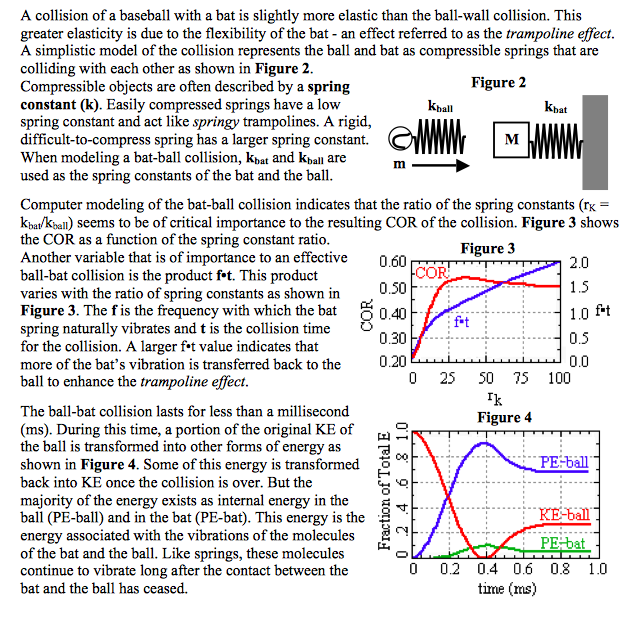 Ball-Bat Collision
Ball-Bat Collision
Resource:
Science Reasoning Center: Ball-Bat Collision
Grade Level: High School
Description:
This passage describes a spring model for explaining the collision between a bat and ball in baseball. Two graphs, an equation and a diagram are used to present information about the transfer and the transformation of energy that occurs during the collision. Questions target a student's ability to make predictions based on an equation, to select values from a graph, to reason towards conclusions that are consistent with a model, and to combine information from two data presentations in order to identify an appropriate conclusion.
Performance Expectation:
HS-PS3-2: Develop and use models to illustrate that energy at the macroscopic scale can be accounted for as a combination of energy associated with the motions of particles (objects) and energy associated with the relative positions of particles (objects).
This activity aligns with the three dimensions of the Next Generation Science Standards in the manner described below:
| Definitions of Energy (HS-PS3.A.2): At the macroscopic scale, energy manifests itself in multiple ways, such as in motion, sound, light, and thermal energy. |
Investigating how energy conservation touches a real-life experience—such as a bat hitting a ball in baseball—is a tangible way to make physics relevant for students. This passage focuses one’s attention on this particular scenario. Energy stored in a compressed spring is used to model the energy transfer that occurs as both the ball and bat are compressed in the collision that takes place in hitting a baseball. The passage discusses that this elastic potential energy is actually the energy associated with molecular vibrations of the bat and the ball both during the collision. A graph within the passage illustrates that a significant portion of the original kinetic energy of the ball is transformed into other forms of energy. |
| System and System Models: Models can be used to represent systems and their interactions. |
Considering the bat and ball as a system, this passage illustrates how energy is conserved within a system even during this interaction. To help model such an interaction and the ‘storage’ of energy during the collision, a compressed spring is used. To illustrate this principle, a graph shows the amounts of various types of energy as a function of time during the collision itself. |
| Energy and Matter: Changes of energy and matter in a system can be described in terms of energy and matter flows into, out of, and within that system. |
By defining the system as either the bat or ball individually, the reader will see that energy flows into or out of the system. An energy graph illustrates how the ball’s original kinetic energy decreases as some of this energy is transferred to the bat’s potential energy when the bat is slightly compressed during the collision. |
| Developing and Using Models: Use a model to predict the relationships between systems or between components of a system. |
In this passage, a compressed spring is used to model the collision that takes place between a bat and ball. Over half the questions at the close of this passage ask the reader to use this model to predict various things about the ball, bat, or the combined system. Furthermore, a computer model is used in the data presentation to indicate that the ratio of the spring constants (rK = kbat/kball) seems to be of critical importance to the resulting coefficient of restitution (COR) of the collision. The computer model illustrates this COR as a function of the spring constant ratio. |
| Engaging in Argument from Evidence: Make and defend a claim based on evidence about the natural world that reflects scientific knowledge, and student-generated evidence. |
At the close of this passage, several questions ask the reader to use evidence from the data presentation to make and defend claims about the bat-ball collision. This process of using data to support claims is not only fundamental the Next Generation Science Standards, it supports the way evidence is used to support claims through the English and Language Arts Common Core standards as well. |
| Using Mathematical and Computational Thinking: Use mathematical models and/or computer simulations to predict the interactions between systems. |
Data generated by a computer simulation is used to model the interaction that occurs during a bat and ball collision. This interaction is further modeled by the compression of a spring, where both the ball and bat have a spring constant (kbat and kball) that describes their ‘compressibility.’ The ratio of these spring constants, rK = kbat/kball, is explored as having an effect on the coefficient of restitution of the bat-ball collision. |
| Obtaining, Evaluating, and Communicating Information: Critically read scientific literature adapted for classroom use to determine central ideas and obtain scientific/technical information. |
As this passage is somewhat technical in nature, it provides the reader a rich opportunity to critically read a scientific study that is related to a common experience for many students—a bat and ball collision in baseball. Several questions at the close of the passage require the student to obtain technical information from within the passage to help make meaning of this study. |
Associated Reading from The Physics Classroom
Other Supporting Pages at The Physics Classroom:
View Infographic.
(Coming Soon)
Search the NGSS Corner
Maybe you're looking for something really specific that pertains to a desired topic and emphasizes one or more of the listed NGSS dimensions. Why not try a search of this section of our website? Simply select from one or more of the pull-down menus and click Search This page will reload and a collection of possibilities will be displayed in this section of the page and sorted by relevancy.